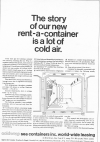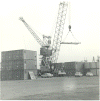 |
Coldwrap - the name
shared by the refrigerated container and a Californian-based food
corporation, a wholly-owned subsidiary of Sea Containers Inc - was
introduced to the public with an advertisement that asked: "What
if a container could provide precise, total control of refrigerated
shipments, over any distance, at any temperature?" and went on to
answer: "It would open up the possibility of distant new mass
markets for delicate perishables . . . [and] . . . would virtually
erase the 20 per cent spoilage that is accepted for perishable shipments
via old type cold containers."
Well, this was prescience indeed! And subsequent developments and
events proved - perhaps for the first time, but certainly not the last -
that Sea Containers was in the vanguard of innovative design in the area
of containerisation. |
 |
In 1965 the ISO freight container started to become widely
seen in Europe. A forwarding agent named Alltransport Ltd agreed to
act as agent for Sea Containers and, via its shipping and forwarding
connections, arrange the leasing, rental and redeliveries of
containers. In order to gain experience of the use of containers in
the short sea trades, to persuade the conservative and conventional
shipowners that they would disregard the advent of containers at the peril
of their balance sheets, and to provide a market for its own containers,
Sea Containers formed a consortium with Alltransport (as marketing
agents), the Nordstrom interests in Finland (as ship operators and
management services). Sea Containers role lay in the provision of
the containers. The photograph shows a typical container crane of the
period - capable of lifting three or four containers an hour. The
shipping line was called Containerships Ltd. |
 |
This picture shows the first of the "dedicated"
container ships chartered-in and operated by Containerships Ltd.
Prior to this the line had been using converted open hold, break-bulk
vessels, and Line Manager, Veli Nordstrom, used to delight in stowing
containers in every last centimetre of space - using the mini-containers
(the 6.7s) in the combings. Despite this intelligent use of the
available space, changes of vessel, changes of schedule, introduction and
removal of different ports of call, the line could not make a sustained
profit. But Sea Containers gained a tremendous amount of experience,
all of which stood it in good stead when planning container, crane and
ship developments subsequently. |
|
|
|
|
|
|
|
|
|
|


